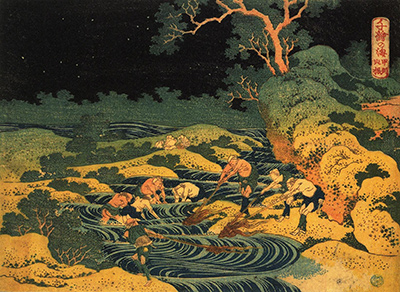Hokusai
Fishing by Torchlight in Kai Province from Oceans of Wisdom by Hokusai
Fishing by Torchlight in Kai Province is a wonderfully atmospheric work of art by the Japanese painter Hokusai. Hokusai lived between 1760 and 1849; he is said to have started painting at the young age of six, and he died in what is now Tokyo.
Throughout his long life of 88 years, Hokusai created numerous works of art that included manga, general woodblock painting and the specific genre of woodblock painting known as Ukiyo-e painting. Ukiyo means ‘floating world’ and it was a genre of art that was devoted to depicting the life of pleasure in present day Japan: courtesans, geishas, buying and selling, sumptuous cloths and the hedonism of city living. Hokusai is often described as being the most famous of the Ukiyo-e painters.
Though it quite literally depicts a ‘floating world’ (the whirling river and the fragile seeming nets tossed upon it), Fishing by Torchlight in Kai Province does not depict a brightly lit scene of hedonism and opulence like many other Ukiyo-e woodblock works. Rather it shows tentative, arduous human labour. The rich colours and the sumptuous draughtsmanship in Fishing by Torchlight in Kai Province, however, make it contiguous with the Ukiyo-e genre as a whole.
Hokusai probably painted Fishing by Torchlight in Kai Province in 1933. It was clear that he executed this work of art during a period in which water was very much on his mind, and not in the metaphorical sense of the ‘floating world’ of courtesans and urbanites, but in a very literal sense. Most people know Hokusai by just one work, ‘The Great Wave’, which he is thought to have painted between 1829 and 1933. This iconic work depicts a huge wave breaking, and it is intriguing to note the different treatments of water in this world famous piece and Fishing by Torchlight in Kai Province. In Fishing by Torchlight in Kai Province, broader strokes are used to denote the rushing river, perhaps. But still, both works are recognisably painted by the great master Hokusai.
